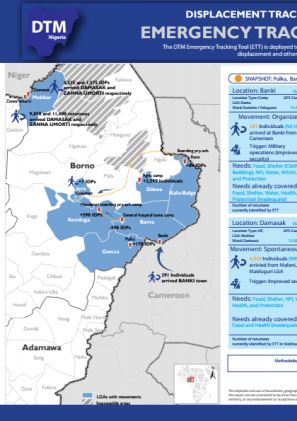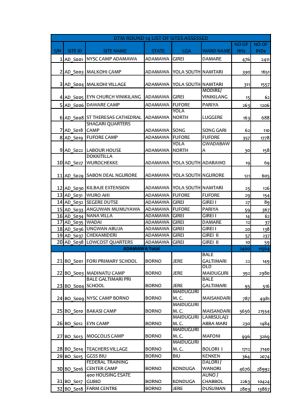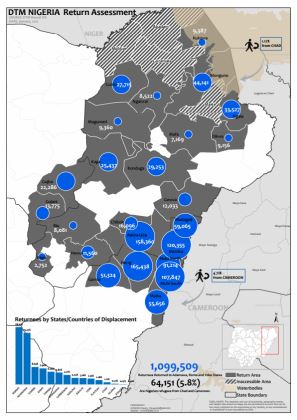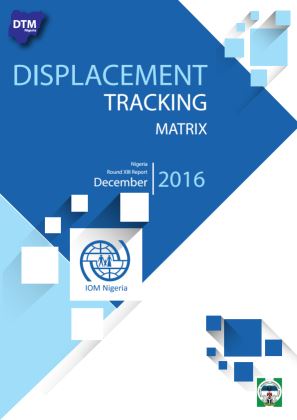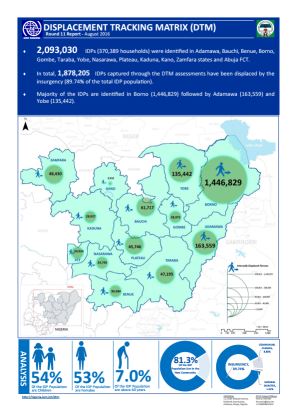-
Countries
-
Data and Analysis
-
Special Focus
-
Crisis Responses
Nigeria
Nigeria
Desplazados internos rastreados
Movimientos de desplazamiento
3,340,000
IDMC 2023
Ronda de recopilación de datos
Sobre Nigeria
The escalation of violence between all parties in north-eastern Nigeria since 2014 has resulted in mass displacement and deprivation in the states of Adamawa, Bauchi, Borno, Gombe, Taraba and Yobe. To better understand the scope of displacement and assess the needs of affected populations, IOM has been implementing its Displacement Tracking Matrix (DTM) programme starting July 2014, in collaboration with the National Emergency Management Agency (NEMA) and State Emergency Management Agencies (SEMAs). The activities of the DTM project, which consist of conducting baseline assessments and registration for IDPs living in camps and host communities, are currently being carried out in Adamawa, Bauchi, Borno, Gombe, Taraba and Yobe.
The information collected will contribute to the provision of a comprehensive profile of the IDP population in Nigeria which will be shared with all relevant stakeholders and will contribute towards enabling the government of Nigeria and humanitarian partners identify the needs of Nigeria's displaced population and develop interventions for providing IDPs necessary assistance.
Contacto
DTM Nigeria
DTMNigeria@iom.int
Current Donors
- ECHO
- BHA
- Canada
Para obtener resultados de búsqueda más avanzados, vaya a la Página de búsqueda avanzada de informes
Nigeria — Yobe Site Profiles 14 (19 December 2016—25 January 2017)
A collection of 5 individual Site Profiles. Site Profiles provide information about demographics, vulnerable groups, mobility, site management and services (Shelter, Health, Wash, Food, and Protection).
Nigeria — Taraba Site Profiles 14 (19 December 2016—25 January 2017)
A collection of 12 individual Site Profiles. Site Profiles provide information about demographics, vulnerable groups, mobility, site management and services (Shelter, Health, Wash, Food, and Protection).
Nigeria — Adamawa Site Profiles 14 (19 December 2016—25 January 2017)
A collection of 20 individual Site Profiles. Site Profiles provide information about demographics, vulnerable groups, mobility, site management and services (Shelter, Health, Wash, Food, and Protection).
Nigeria — Displacement Dashboard 14 (January 2017)
As of January 25, 2017, DTM has identified 1,899,830 IDPs (337,353 households) across Adamawa, Bauchi, Borno, Gombe, Taraba, and Yobe states.
Nigeria — Displacement Report 14 (January 2017)
Between December 2016 and January 2017, the number of identified IDPs increased by 129,386 individuals (7.3% increase). This brought the total number if IDPs in Nigeria to 1,899,830 (337,353 households).
Feb 14 2017
Nigeria — Displacement Report 14 (January 2017)
Nigeria — Emergency Tracking Tool Report 1 (27 January — 10 February 2017)
The DTM Emergency Tracking System (ETS) was deployed to track and provide up-to-date information on sudden displacement and return movements. The report provides information about the type and trigger of the population movements as well as estimated number of people.
Nigeria — Yobe Site Profiles 14 (19 December 2016—25 January 2017)
This document contains the site profiles for all displacement sites identified in Yobe state, Nigeria.
Nigeria — Taraba State Site Profiles 14 (20 December 2016—25 January 2017)
This document contains the site profiles for all displacement sites identified in Taraba state, Nigeria.
Nigeria — Borno Site Profiles 14 (19 December 2016—25 January 2017)
This document contains the site profiles for all displacement sites identified in Borno state, Nigeria.
Nigeria — List of Wards Assessed 14 (19 December 2016—25 January 2017)
This document lists all the wards assessed in DTM Round 14 by state and Local Government Area, showing the total number of displaced individuals and households identified.
Nigeria — List of Displacement Sites Assessed 14 (19 December 2016—25 January 2017)
This document lists all the sites assessed in DTM Round 14 including the site ID, site name, state, Local Government Area, ward name, number of households and number of individuals.
Nigeria — Returnee Dashboard 14 (19 December 2016—25 January 2017)
1,099,509 returnees to Adamawa, Borno and Yobe states were identified. 64,151 (5.8%) are Nigerian refugees from Chad and Cameroon.
Nigeria — Location Based Assessment Report 13 (1 July 2014—31 December 2016)
As of 31 December, the conflict in the northeastern part of Nigeria has left an estimated 1,770,444 people displaced across the 6 most affected states.
Nigeria — Rann LGA Flash Report (13 January 2017)
Situated on the international border between Cameroon and Nigeria, Kala Balge is a Local Government Area (LGA) in the conflict-affected Nigerian State of Borno. The current estimated population of IDPs is 35,295 individuals.
Nigeria — Kukawa LGA Flash Report (13 January 2017)
Located in the northern part of the conflict-affected state of Borno, Kukawa Local Government Area borders Lake Chad. Out of its 10 wards, only four are accessible, namely: Baga, Doro, Kauwa and Kukawa. The DTM identified 11,700 IDPs [2,283 households (HHs)] in Kukawa LGA.
Nigeria — Displacement Report 13 (December 2016)
The DTM Round 13 assessment focused on the six northeastern Nigerian states most affected by the ongoing conflict; Adamawa, Bauchi, Borno, Gombe, Taraba, and Yobe. The following DTM report covers a total of 106 LGAs and 751 wards.
Dec 23 2016
Nigeria — Displacement Report 13 (December 2016)
Nigeria — Site Assessment Dashboard 7 (October 2016)
This Site Assessment Dashboard identified 161 camps and camp-like settings (formal and informal camps) housing 398,749 IDPs. 55% (or 130,131) of the IDP Children population are female and 56% of the IDP population are females. 5.4% (or 21,539) of the IDP population are above 60 years old.
Nigeria — Displacement Report 12 (October 2016)
As of 31 October 2016, the Displacement Tracking Matrix (DTM) has identified 1,822,541 internally displaced persons (IDPs) - 321, 514 families - displaced since the escalation of violence in 2014.
Nov 10 2016
Nigeria — Displacement Report 12 (October 2016)
Nigeria — Displacement Report 11 (August 2016)
2,093,030 IDPs (370,389 households) were identified in Adamawa, Bauchi, Benue, Borno, Gombe, Taraba, Yobe, Nasarawa, Plateau, Kaduna, Kano, Zamfara states and Abuja FCT. In total, 1,878,205 IDPs captured through the DTM assessments have been displaced by the insurgency (89.74% of the total I
Sep 15 2016
Nigeria — Displacement Report 11 (August 2016)
Nigeria — Displacement Report 10 (June 2016)
2,066,783 IDPs (344,564 households) were identified in Adamawa, Bauchi, Benue, Borno, Gombe, Taraba, Yobe, Nasarawa, Plateau, Kaduna, Kano, Zamfara states and Abuja FCT.
Jul 15 2016
Nigeria — Displacement Report 10 (June 2016)
Nigeria — Plateau Site Profiles 9 (1 March 2016—30 April 2016)
This document contains the site profiles for all displacement sites identified in Plateau state, Nigeria during the reporting period.
Nigeria — Nasarawa Site Profiles 9 (1 March — 30 April 2016)
This document contains the site profiles for all displacement sites identified in Nasarawa state, Nigeria.
Nigeria — Kano Site Profiles 9 (1 March — 30 April 2016)
This document contains the site profile for the displacement site identified in Kano state, Nigeria.
Nigeria — Kaduna Site Profiles 9 (1 March 2016—30 April 2016)
This document contains the site profiles for all displacement sites identified in Kaduna state, Nigeria.
Pagination
Para obtener resultados de búsqueda más avanzados, vaya a la Página de búsqueda avanzada de conjuntos de datos
Pagination
- First page
- Previous page
- 1
- 2
- 3
- 4
- 5
- 6
- 7
- 8
Pagination
- First page
- Previous page
- 1
- 2
- 3
- 4
- 5
- 6
- 7







